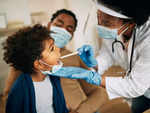Why are more kids getting infected in the third wave? Here's all we know about the symptoms and severity
More kids getting infected in the third wave

During the COVID-19 third wave we can see a high number of infections in children. While the infection rate is spreading at a tremendous rate among adults, in children its impact has started getting visible. As on January 14, 2022, India reported a total of 2,64,202 new COVID cases.
Why are kids getting infected?

The primary reason is pretty obvious as kids share the same space as the adults and the coronavirus is rapidly spreading among adults. Another reason that may contribute to the growing COVID-19 infection among kids owes to the research studies which say due to their high immunity kids are less prone to catch the infection. This has led to a perception among general people that kids have a strong immunity power which can fight off the disease. Another reason is that kids can't be quarantined. Since at this age it is not feasible to leave them unattended, it increases their chance of getting the infection from the parents or the caregiver.
Why are less cases in COVID infection among kids reported?

The biggest reason behind this is less testing among kids. Since COVID-19 symptoms overlap with common cold symptoms and common cold is a very regular occurrence in kids, it is not possible to differentiate between the two infections. Presence of even mild symptoms of COVID-19 can go unnoticed in kids.
Severity of COVID-19 in kids

COVID-19 infections among children and adolescents cause less severe illness and fewer deaths compared to adults, the WHO says. "Younger children, school children and adolescents usually have fewer and milder symptoms of SARS-CoV-2 than adults and are less likely than adults to experience severe COVID-19. The biological mechanisms for the age related differences in severity are still under investigation but hypotheses include differences in the functioning and maturity of immune systems in young children compared with adults," it had said in a report published in September, 2021.
Why should COVID infection among kids be taken seriously?

Even if it is not serious in kids, still kids do carry the infection in them. Even without showing any symptoms or when showing mild symptoms, they are the carriers of the virus. Eventually they also contribute to the transmission of the disease much like any adult. Moreover, currently there is no vaccination available for this age group. Therefore understanding the symptoms, infectivity and patterns of coronavirus transmission in children is very important. As per global data, COVID-19 outbreaks have been identified in secondary schools, summer camps and day care centres. Reports of COVID-19 cases among children after reopening of schools also substantiates why COVID in kids should be taken seriously.
What should parents do?

Parents should be more careful regarding this. If you have a small child with you, you need to follow the COVID safety guidelines religiously. Parents should avoid going outside, should always wear masks, keep their surroundings properly sanitized and keep the child away from any sort of external contact.
Parents should always seek medical assistance in case any symptom is visible.
Since there is no COVID-19 vaccination available for kids in the country right now, parents should make sure their kids get vaccinated against flu so that the impact of coronavirus is lessened to some extent when the infection occurs. Though there is no evidence on substitution of flu vaccine for COVID-19 in kids, since the symptoms of both the infections are similar experts have recommended it.
What are the symptoms of COVID-19 seen in kids?

Typical COVID-19 infection symptoms in kids are: cough, fever, shortness of breath, body ache, sore throat, loss of taste or smell, diarrhea, nausea, fatigue and congestion or runny nose. While fever and cough are said to be the common symptoms of COVID-19, the other symptoms have also been observed in kids.